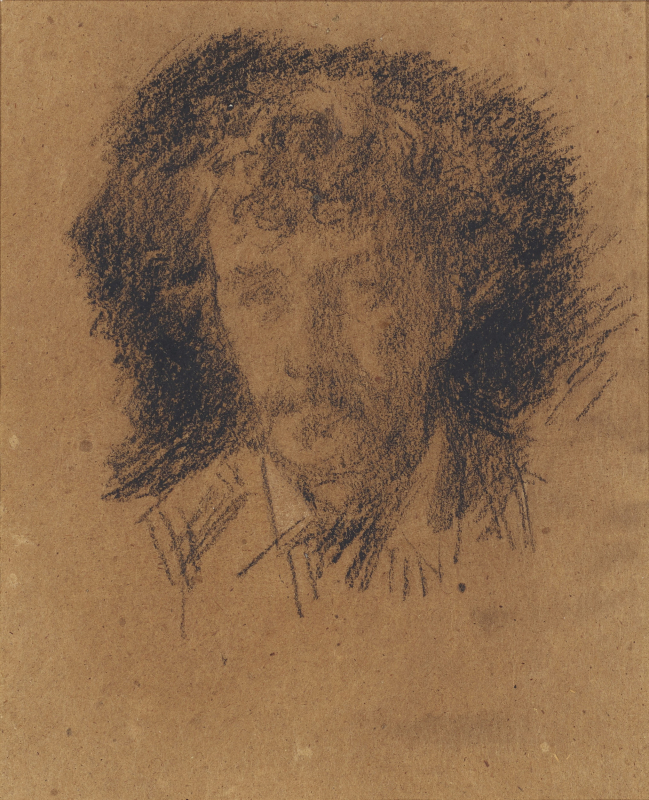Technique
The 1995 catalogue raisonné describes it as follows:
'The orangey brown paper has a strong vertical grain, and large fragments of stalk. The soft touches of chalk blend with the grain of the brown paper to give a solid and rounded picture. In contrast, wiry lines of loose curls over the hair and the angular shading on the white shirt enliven the drawing. There are traces of white in the collar and eye. There are three pin-holes at centre top.' 1
MacDonald discusses this self-portrait:
'On 31 October 1893 Whistler told T. R. Way, concerning a drawing acquired by his father, the lithograph master-printer Thomas Way, and now in the Freer Gallery of Art: ‘About the drawing I dont remember giving it to your Father - but if I did, it surely must have been by myself! - I think he will know that I am scarcely in the habit of collecting the sketches of my contemporaries!!!! - Besides know that at one time I always made a drawing before going to bed! - of myself I mean - though I finally destroyed most of them - I hope his one is not so very bad - though doubtless if I had it here I would pop it in the fire - where I daresay it ought to have gone with the rest! - Perhaps one of these evenings I shall do another!’ 2… In the 1870s Whistler did indeed make a series of self-portraits in chalk, charcoal, and pastel on brown paper, measuring between about 7 x 6” and 11 x 7”. It is hard to date these works, because they were undoubtedly drawn over a fairly short period, but they share certain characteristics of medium, style and technique. ...
Other known self-portraits include a head and shoulders, three-quarter face, view of the artist, drawn in charcoal and touched up in wash, in Colby College Museum of Art (r.: Self-portrait; v.: standing woman [M.0463]). He is lit from the left and the area behind him to left is deeply shadowed: a white lock in his curly hair is touched with white chalk. Another Self-portrait is in the Art Institute of Chicago (Self-portrait [M.0422]): the artist is again lit from the left, behind, so that the light falls on the paper held in his hands, close to his chest. Bold diagonal lines from lower left to upper right unify the figure with the surrounding shadows.
Two self-portraits are in the Freer Gallery of Art (Portrait of the Artist [M.0682], r.: Portrait of the Artist; v.: Nude [M.0683]). One shows just the head, the other, a half-length, shows him drawing, the paper on a table before him, the light catching his hand and face and white lock, and casting deep shadows behind.
The present drawing, Portrait of the artist, is similar in size to the smaller of the two Freer Gallery works (Portrait of the Artist [M.0682]), and, like that, is somewhat vignetted. The artist stares ahead, almost straight on, and is lit from the left, illuminated against a shadowed area indicated by masses of diagonal chalk lines. He was likely working by flickering candlelight or by the light of the fire. A soft effect is adopted for the face, making use of the rough texture of the orangey-brown paper, rubbing the broad chalk lightly over the grained surface with its occasional flecks of stalk – a very satisfying surface to work on. Very light touches of white chalk highlight the face and collar at left. A few sharper black lines outline his face to left, others indicate the angular lines of jacket and collar. Tiny dots on his eyes define the pupils, accentuating his piercing gaze.
Wiry lines enliven the curly mass of dark hair, where the white lock is noticeable. Whistler self-consciously refined his distinctive appearance, combing his hair to reveal this white lock, a genetic mutation called the Waardenburg syndrome. A visitor to the Whistler household, Anne Benson Procter, described him acutely in 1877 as 'a very remarkable looking person – dark – eyes and hair – and one white lock, on his forehead – all the family have this – He thinks very highly of his own works.' And so he did, he was not modest! but he was, as this drawing shows, self-critical. Here, Whistler does not glamorise himself: he sees and shows himself a serious, intent figure. It is a very sensitive, introspective, and subtle selfportrait of an artist well-known for the very different qualities of affected dandyism and aggressive self-publicising. It is also a fine, satisfying, and rather beautiful work.' 3
Last updated: 3rd February 2021 by Margaret





